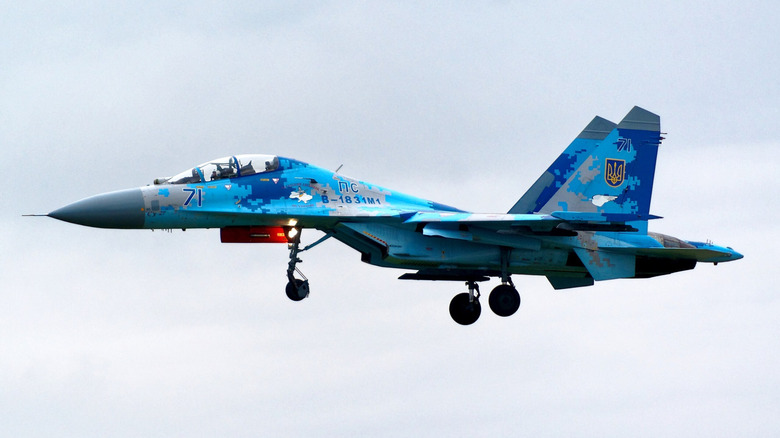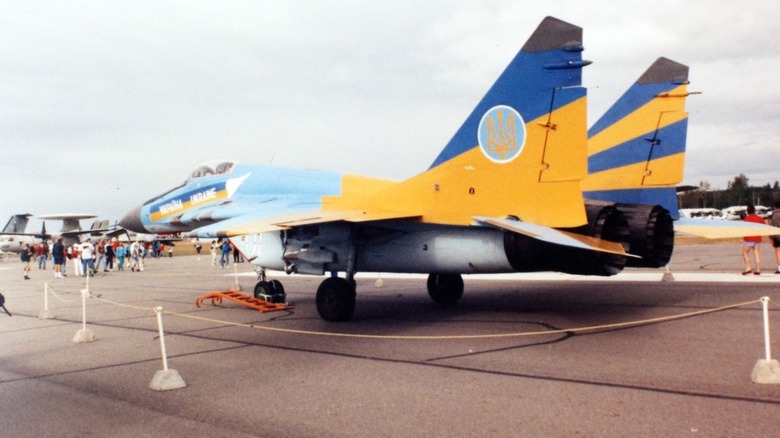Ukraine Is Putting American Decoy Missiles On Russian Fighter Jets
In warfare, there is a range of factors that determine engagements. Numbers, of course, can have a huge influence, and air supremacy can be absolutely pivotal too. It's not just about powerful weapons, though, but about the way in which they're used. Today, sophisticated global intelligence and air defenses can give forces a significant warning as to when opponents are going to strike, and how. They are not infallible, but have a prominent role in reducing the impact of an onslaught. With mass drone strikes from the likes of the dreaded Shahed drones used by Russia being such a popular strategy, the goal is often to try to overwhelm these defenses through sheer numbers, ensuring that at least some reach their targets.
The biggest consideration, though, is that the drones used for this are, individually, typically of little value or impact. With bigger, more sophisticated, and generally far more costly weapons, it would be an awful waste to simply have them destroyed. They may be launched in the midst of a broader attack from lots of these low-value drones, for instance. Alternatively, there are missiles that are designed to act like or appear to be other types of aerial threats, and Ukraine has begun to wield these innovative and deceptive missiles on its Su-27 fighter jets.
The MALD, or Miniature Air-Launched Decoy, was developed by the United States. For embattled Ukrainian forces, it may be able to serve two important roles at once: Not only deceiving and potentially bypassing Russian air defenses, but also helping modernize the fighters on which they're equipped. It's a very unique weapon, and one well-suited to the challenges of the specific war being fought and the capacities of both sides.
How the Miniature Air-Launched Decoy works
The resourcefulness and ingenuity of both Ukrainian and Russian forces have been particularly evident throughout the conflict. For instance, the ubiquitousness of electronic countermeasures that can take them down led to a rise in drones with fiber optic cables, which are connected to their operator via a long cable and, as such, are not susceptible to such attacks. Being tethered to the drone in this fashion could be a weakness in itself, but it's just one example of the ways that both sides, as in any war, have battled to adapt to the changing conditions on the field and how to overcome the challenges they face.
Ukraine has been given a wide range of weapons from international allies, such as the formidable Storm Shadow missiles from the U.K. and the Leopard 1 and Leopard 2 tanks from Germany. Even the most potent of weaponry, however, will have little effect if Russia can effectively counter it. Like the great quantities of drones, the decoy missiles can confuse and preoccupy air defenses. They aren't really a direct threat, but they resemble something much more dangerous, which forces a response.
According to The War Zone, a Ukrainian Air Force pilot explained in August 2025 that, "At the same time, at another airfield, our comrades are programming Storm Shadow or SCALP missiles to strike the enemy. In cooperation with the strike groups during such operations, we use HARM anti-radar missiles." Manufacturer Raytheon states that the key to the MALD's effectiveness is that it "duplicates the combat flight profiles and signatures of U.S. and allied aircraft," thereby convincing opposing forces that they have detected a missile that the MALD is mimicking. The real thing, meanwhile, can strike more freely.
A critical part of Ukraine's defensive strategies
Heavy missile bombardment is a constant threat during the war in Ukraine, and air defenses are a constantly strained resource as a result. As such, defenses such as Russia's hefty S-500 defense system are concentrated in Crimea. For the Ukrainians, meanwhile, the capital of Kyiv boasts the greatest concentration of ally-provided defense systems it can muster, including the U.S.-built Patriot system. Even in such cases, there is no perfect defense.
The MALD system is part of a wider offensive and defensive network of different strategies and systems that Ukraine uses. The broader aims are twofold: To mitigate the damage of Russian assaults and to try to make its own as effective as possible. In August 2024, Ukrinform reported that Colonel Yurii Ihnat of the Ukrainian Air Force stated on Ukrainian radio, "active means of defense," such as Patriot missile systems, are "extremely few in Ukraine ... we [also] need passive defense measures." In the latter category, Colonel Ihnat noted that sneaky decoys like ground vehicles are also used.
An MALD, then, could be seen as falling between the two categories. It has a considerable range of 500 miles, and this means that it can either be used at a greater distance (thereby helping to safeguard the pilot who launched it) or remain active for longer, further confounding opposing radar and weapons systems. Raytheon has also developed the MALD-J, a variation on the model that features electronic jamming properties. The MALD systems are attached to pylons on the Su-27, which pass on location information for the device once it's fired, as the Su-27 does not have its own sophisticated in-built GPS. The MiG-29, another effective Soviet fighter jet (pictured here), has also been equipped with the MALD missile in a similar fashion.


